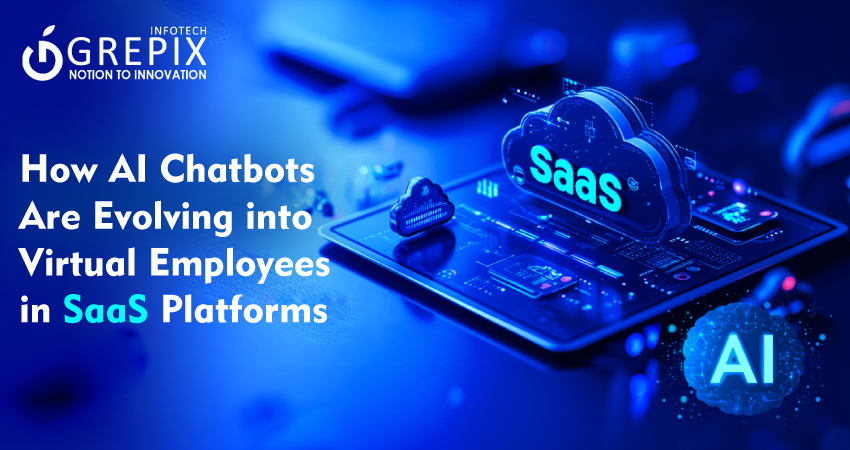How AI Chatbots Are Evolving into Virtual Employees in SaaS Platforms
In the dynamic world of Software-as-a-Service (SaaS), automation is not just a luxury it’s a necessity. AI chatbots have long served as the first point of contact between customers and companies. But in 2025, they have morphed from basic conversational tools into fully functional virtual employees. They are capable of handling onboarding, sales queries, technical support, and even managing cloud cost optimization. The evolution of these digital agents is not just fascinating but deeply transformative for businesses worldwide.
In this blog, we will explore how AI chatbots are evolving into virtual employees in SaaS platforms, with a deep dive into their features, real-world applications, decision-making frameworks, and how they influence business processes. This journey will also include insights into AI integration in apps, a comparison of platforms like Flutter and React Native in this context, and a look into how cloud cost optimisation is now being managed by AI.
AI chatbots in SaaS are no longer static scripts answering FAQs. They have transformed into virtual employees capable of real-time decision-making, automation, and user engagement. Businesses adopting these AI tools report reduced costs, better user experiences, and improved scalability. Whether it’s cloud cost optimization, onboarding, or AI integration in apps, the impact is undeniable. Companies like Grepix Infotech are leading the way by developing platforms where AI is not just support it’s strategic.
Why AI Chatbots Became Critical in SaaS
Before they evolved into full-blown virtual employees, AI chatbots were adopted by SaaS platforms for three primary reasons:
- Scalability: They allow companies to serve thousands of users simultaneously.
- Cost-efficiency: Hiring human agents for 24/7 support is expensive. AI brings that cost down dramatically.
- Consistency: Unlike humans, bots don't suffer from fatigue, mood swings, or memory lapses.
As SaaS applications became more advanced and customer bases expanded globally, the need for a 24/7, multilingual, scalable workforce became apparent. AI was the only logical solution.
From Chatbots to Virtual Employees: What Changed?
Old-School Chatbots:
- Predefined answers
- Menu-based interaction
- No learning capabilities
Modern Virtual Employees:
- Use NLP and NLU to understand context
- Integrate with CRMs, databases, APIs
- Learn from user interactions over time
- Handle complex queries and take autonomous actions
Today’s AI chatbots use technologies like GPT-4, Google BERT, and proprietary LLMs to provide personalized, intelligent, and proactive responses. They are no longer waiting to be told what to do they anticipate needs, trigger workflows, and analyze data in real-time.
Key Feature Comparison: Chatbots vs Virtual Employees
Traditional Chatbot vs. Virtual Employee
| Feature | Traditional Chatbot | Virtual Employee |
|---|---|---|
| Technology Stack | JavaScript, DialogFlow | NLP/ML APIs, LLMs, Python, GPT |
| Integration | Surface-level UI help | Deep SaaS integration (CRM, billing, etc.) |
| Response Logic | Rule-based | Contextual + predictive |
| Learning Capability | None or limited | Adaptive, improves with use |
| Task Handling | FAQs, simple actions | End-to-end workflows |
| User Experience | Linear | Conversational + dynamic |
Real-World Use Cases
Let’s explore how SaaS platforms are using these virtual employees in real-world scenarios:
1. Customer Support Automation
Companies like Zendesk, Intercom, and Freshdesk are deploying virtual assistants that resolve up to 80% of Tier 1 queries without human involvement.
Example: A customer asks about their subscription. The AI bot checks the CRM, verifies billing data, and provides a direct answer without involving a support agent.
2. Sales Enablement and Lead Qualification
AI chatbots on platforms like HubSpot and Drift now:
- Greet website visitors
- Understand their intent
- Collect lead data
- Qualify prospects
- Book meetings with sales reps
3. Onboarding and Product Tours
SaaS tools like Notion and Slack use bots to guide new users through:
- Tutorials
- Feature discovery
- Setup workflows
These bots are context-aware and provide tips based on user behavior.
4. Cloud Cost Optimisation
Platforms like Spot.io, Datadog, and AWS Cost Explorer use AI bots to:
- Monitor cloud usage
- Flag underutilized resources
- Suggest scaling actions
- Forecast costs
The bot essentially acts as a financial advisor for your DevOps team.
5. HR and Internal Operations
In platforms like ServiceNow, AI bots:
- Process leave requests
- Handle employee queries
- Route tasks to departments
The Role of AI Integration in App Development
AI integration in SaaS apps is no longer optional. Companies are building with AI-first principles in mind. Whether you're choosing Flutter or React Native for mobile development, integrating AI components like chat, recommendation engines, or analytics dashboards is now expected.
Key Considerations:
- React Native vs Flutter 2025: When building for cross-platform apps with AI features, both frameworks are excellent. React Native has broader community support, while Flutter offers better performance with Dart when it comes to rendering complex UI interactions.
- AI Integration Software: TensorFlow, DialogFlow, OpenAI APIs, Rasa, and IBM Watson are top choices. These platforms offer SDKs for both Flutter and React Native.
Keywords integrated: compare flutter react native 2025, ai integration software
Decision-Making Framework: Should You Deploy a Virtual Employee?
Here’s a simple decision-making guide for SaaS companies:
Step 1: Identify the Problem
- Are support tickets overwhelming your human agents?
- Is customer onboarding inconsistent?
- Is cloud usage and cost growing unpredictably?
Step 2: Evaluate Tasks for Automation
- Repetitive and predictable tasks are ideal
- Any task with a clear SOP (standard operating procedure) can be automated
Step 3: Choose the Right Technology
- Simple chat: Use Dialog Flow or Tidio
- Conversational AI: Go with OpenAI + Langchain
- Cloud Optimization: Use AWS AI tools or third-party cloud advisors
Step 4: Run a Pilot
Test the AI bot on a small user segment. Evaluate:
- Speed
- Accuracy
- CSAT (customer satisfaction)
Step 5: Scale Across Departments
Expand from customer support to sales, finance, and HR.
Also Read: "AI-Powered SaaS: The New Benchmark for Productivity"
How Virtual Employees Impact SaaS Business Models
The introduction of AI virtual employees has made a significant dent in the traditional SaaS cost and revenue model.
Reduced Operational Costs:
- Fewer support agents needed
- Lower cloud expenses through AI optimization
- Faster resolution times mean higher retention
Increased Revenue:
- Smart AI nudges users toward upgrades
- AI in product tours increases adoption
- AI-enhanced personalization improves conversion rates
New Business Opportunities:
- White-labeled AI assistants as add-ons
- AI chatbots as a service (for other startups)
Example: AI integration in apps has helped some SaaS companies cut churn by 20%.
The AI-Powered Future: What to Expect
Near-Term (2025-2026):
- Better multilingual support
- Industry-specific bots (legal, healthcare, finance)
- Integration with voice assistants like Alexa or Siri
Mid-Term (2027-2029):
- Bots managing product roadmaps
- Predictive analytics and decision-making
- Complete automation of helpdesks
Long-Term (2030+):
- AI bots as team leads or department heads
- Bots training other bots using reinforcement learning
Imagine a SaaS platform where 50% of your team is virtual but performs as well (or better) than your human team.
Conclusion: The Role of Grepix Infotech in Building AI Powered SaaS Solutions
Grepix Infotech, a leader in mobile and SaaS application development, is playing a pioneering role in transforming AI chatbots into virtual employees. With extensive expertise in Flutter, React Native, Node.js, AI/ML technologies, and cloud platforms like AWS and Google Cloud, Grepix helps businesses:
- Build and scale intelligent chatbots
- Integrate AI seamlessly into mobile and web apps
- Optimize cloud infrastructure using predictive algorithms
- Deliver multilingual, multi-platform chatbot solutions
Whether you're launching a startup or scaling your existing SaaS tool, Grepix ensures your AI workforce is not just operational but a strategic advantage.
With Grepix Infotech, your virtual employees aren’t just part of the system they are the system.
FAQs
1. How are AI chatbots different from virtual employees?
Chatbots answer basic queries. Virtual employees handle complex workflows, make decisions, and integrate across SaaS systems.
2. Can AI chatbots improve cloud cost efficiency?
Yes, by analyzing usage, suggesting scaling, and auto-triggering optimization tasks.
3. Which is better in 2025: Flutter or React Native for AI integration?
Both are great. Flutter offers better performance, while React Native provides community support and third-party plugins.
4. How do I decide if my SaaS needs a virtual employee?
Start with analyzing high-volume, repetitive tasks. If automatable, you likely need one.
5. How can Grepix help my SaaS business adopt AI?
Grepix offers end-to-end AI integration, chatbot development, and cloud optimization tailored for SaaS applications.
Launch your vision with our mobile app development company, where innovation meets excellence to create cutting edge mobile solutions."







